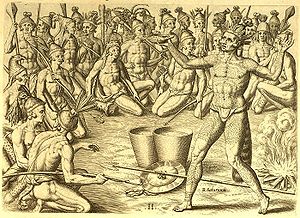 One of Theodor de Bry's engravings, supposedly based on drawings by Jacques LeMoyne, depicting Chief Saturiwa preparing his men for battle | |
| Total population | |
|---|---|
| Extinct as tribe | |
| Regions with significant populations | |
| North Florida around the mouth of the St. Johns River (present-day Jacksonville) | |
| Languages | |
| Timucuan language, Mocama dialect | |
| Religion | |
| Native | |
| Related ethnic groups | |
| Timucua |
The Saturiwa were a Timucua chiefdom centered on the mouth of the St. Johns River in what is now Jacksonville, Florida. They were the largest and best attested chiefdom of the Timucua subgroup known as the Mocama, who spoke the Mocama dialect of Timucuan and lived in the coastal areas of present-day northern Florida and southeastern Georgia. They were a prominent political force in the early days of European settlement in Florida, forging friendly relations with the French Huguenot settlers at Fort Caroline in 1564 and later becoming heavily involved in the Spanish mission system.
The Saturiwa are so called after their chief at the time of contact with the Europeans, Saturiwa. At that time the chief's main village was located on the south bank of the St. Johns River, and he was sovereign over thirty other chiefs and their villages. Chief Saturiwa allied with the French, who built Fort Caroline in Saturiwa territory, and later aided them against the Spanish of St. Augustine. After the French were dislodged from Florida, the Saturiwa made peace with the Spanish, who established Mission San Juan del Puerto near their main village. Like other Florida native peoples, the Saturiwa were decimated by new infectious diseases and warfare through the 17th century. They disappear from the historical record by the start of the 18th century; surviving Saturiwa likely merged with other Timucua and lost their independent identity.[1]
- ^ Swanton, pp. 138–139.